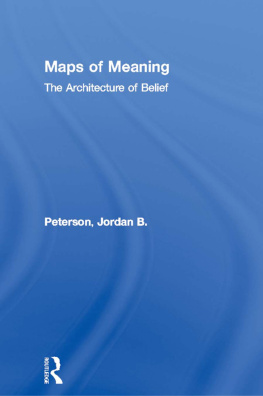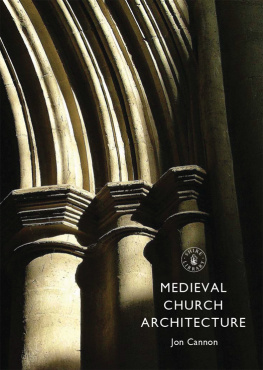Bandmann Gunter - Early Medieval Architecture as Bearer of Meaning
Here you can read online Bandmann Gunter - Early Medieval Architecture as Bearer of Meaning full text of the book (entire story) in english for free. Download pdf and epub, get meaning, cover and reviews about this ebook. year: 2011, publisher: Columbia University Press, genre: Religion. Description of the work, (preface) as well as reviews are available. Best literature library LitArk.com created for fans of good reading and offers a wide selection of genres:
Romance novel
Science fiction
Adventure
Detective
Science
History
Home and family
Prose
Art
Politics
Computer
Non-fiction
Religion
Business
Children
Humor
Choose a favorite category and find really read worthwhile books. Enjoy immersion in the world of imagination, feel the emotions of the characters or learn something new for yourself, make an fascinating discovery.
- Book:Early Medieval Architecture as Bearer of Meaning
- Author:
- Publisher:Columbia University Press
- Genre:
- Year:2011
- Rating:5 / 5
- Favourites:Add to favourites
- Your mark:
- 100
- 1
- 2
- 3
- 4
- 5
Early Medieval Architecture as Bearer of Meaning: summary, description and annotation
We offer to read an annotation, description, summary or preface (depends on what the author of the book "Early Medieval Architecture as Bearer of Meaning" wrote himself). If you haven't found the necessary information about the book — write in the comments, we will try to find it.
Early Medieval Architecture as Bearer of Meaning — read online for free the complete book (whole text) full work
Below is the text of the book, divided by pages. System saving the place of the last page read, allows you to conveniently read the book "Early Medieval Architecture as Bearer of Meaning" online for free, without having to search again every time where you left off. Put a bookmark, and you can go to the page where you finished reading at any time.
Font size:
Interval:
Bookmark:
 | Early Medieval Architecture AS BEARER OF MEANING |
| Early Medieval Architecture AS BEARER OF MEANING GNTER BANDMANN Translated, with an introduction, by Kendall Wallis AFTERWORD BY HANS JOSEF BKER COLUMBIA UNIVERSITY PRESS |
COLUMBIA UNIVERSITY PRESS
Publishers Since 1893
NEW YORK CHICHESTER, WEST SUSSEX
cup.columbia.edu
Translation copyright 2005 Columbia University Press
All rights reserved
E-ISBN 978-0-231-50172-9
Bandmann, Gnter:
Mittelalterliche Architektur als Bedeutungstrger
Berlin: Gebrder Mann Verlag, 1951
Originally published 1951, 11th printing (Mann Studio-Reihe) 1998
Library of Congress Cataloging-in-Publication Data
Bandmann, Gnter.
[Mittelalterliche Architektur als Bedeutungstrger. English]
Early medieval architecture as bearer of meaning / Gnter Bandmann ; translated, with an introduction, by Kendall Wallis ; afterword by Hans Josef Bker.
p. cm.
Translation of: Mittelalterliche Architektur als Bedeutungstrger.
Includes bibliographical references and index.
ISBN 0-231-12704-9 (cloth : alk. paper)
1. Architecture, Medieval. 2. Symbolism in architectureEurope. 3. Christian art and symbolismMedieval, 5001500. 4. Decoration and ornament, ArchitecturalEurope. 5. Decoration and ornament, Medieval. I. Title.
NA350.B3313 2005
720.9409021dc22
2004059374
A Columbia University Press E-book.
CUP would be pleased to hear about your reading experience with this e-book at .
Designed by Chang Jae Lee

The fox knows many things,
but the hedgehog knows one big thing.
ARCHILOCHUS
For my wife, Faith,
who has made this possible,
as she does all things.
Contents
Bearing Bandmanns Meaning:
A Translators Introduction by Kendall Willis
T HE TRANSLATOR WISHES TO EXTEND his deep and heartfelt thanks to Warren and Edith Sanderson, for first nurturing his fascination with westworks and then cultivating it in delightful company; Hans Bker, for first assuring him that the text was impossible to translate and then helping him see it to completion with wisdom and charm; Malcolm Thurlby and Roger Stalley, for encouraging him at the right time; Wendy Lochner of Columbia University Press, for believing in the book; Irene Pavitt, of Columbia University Press, and Almuth Seebohm and Sabine Seiler, for making sure that he wrote what he both wanted and needed to write; Eric Ormsby, Calvin Evans, and Frances Groen of the McGill University Libraries, for believing that this decade-long gestation would bring forth a worthy contribution to scholarship; and his beloved Faith, without whose love, wit, patience, scholarship, gift for the right word at the right time, and tolerance for Mr. B, this book could never have happened.
I NNOVATIVE WORKS OF SCHOLARSHIP, especially those with a theoretical orientation, present a special challenge to the translator because new ideas require, and inevitably engender, new terminology. New terms are created in many ways. Scientists, philosophers, and theologians traditionally fashion vocabulary by forcing new shoots from old Greek or Latin rootseverything from transubstantiation to angioplasty. Vernacular neologisms can be created, like being-in-the-world. Terms can also be carried over unchanged from another language where they were coined and endowed with specific meanings, like Dasein and Zeitgeist.
But there is another way to describe the hitherto indescribable, and that is through metaphor. When early Christians tried to express a new concept of leadership and authority, they did so by appropriating the terminology of sheep-herding. The familiar relationship of shepherd and sheep, when projected into a different context (e.g., God as Good Shepherd of humanity, the bishop as pastor of the faithful flock), conveyed an entirely novel concept: spiritual authority grounded in service and sacrifice.
Gnter Bandmann, perhaps because he was primarily interested in how meanings are conveyed symbolically by the purposeful manipulation of specific architectural forms, relied on metaphorical extensions of preexisting German words rather than on neologisms. From the translators perspective, the challenge then is to find equivalent English terms that capture Bandmanns special metaphors and at the same time acknowledge the literal meaning of the words whose significance Bandmann has extended. Sometimes the metaphor has worked, and sometimes it has had to be banalized, ironically, to save the meaning from the image. For the sake of greater clarity for English-speaking readers, the metaphorical or implied meaning was at times made explicit, through repetitions of key terms and concepts or parenthetical clarification.
Bandmann uses some apparently univocal terms, such as form and type, in technical ways that are based on his art historical premises. The following notes will alert the reader to some of these key concepts and metaphorical usages and will attempt to make them more comprehensible. The terms that have proved most difficult to translate are precisely those most intimately connected with acts of transmission and reception of meaning.
Form and Type
In Early Medieval Architecture as Bearer of Meaning, Gnter Bandmann argues that an architectural form, such as a dome, considered as an abstraction, can be used to convey a meaning. The importance Bandmann ascribes to form as abstraction has consequences for the English-speaking reader, who must become accustomed to some unusual precision in the use of definite and indefinite articles. When Bandmann speaks of the dome, he is referring to the abstract idea of the dome, almost in the Platonic sense. The statement the dome is a circular vaulted covering of a large space with no interior supports is applicable to all domes, but refers to no particular dome. A dome, by contrast, denotes a particular and concrete dome. A dome may have an opening in the center is a true statement about some particular and actual domes, but not all. Finally, the term domes denotes all particular, actual domes, as they might appear on a poster entitled Domes of the World. Domes come in all sizes and shapes is universally true, but it is true about particular and concrete domes. By contrast, the statement the dome is an image of the vault of heaven, refers, in Bandmanns way of speaking, to the abstraction or idea of the dome; concrete and particular domes will partake of this idea to a greater or lesser degree, depending on their specific construction and circumstances.
A dome (or a domed building) is the structures form. Formal is the adjective describing the builders intention with regard to the form. The buildings formal design means the buildings design with respect to forms in this quasi-Platonic sense. For example, when Bandmann writes that the metaphor of the city has formal consequences for the design of the church building, the city should be understood as the abstract idea of the city (in this case, the abstract idea held in late Antiquity). Visually it was marked by circumferential walls, multiple rooflines, and monumental gates. Structurally it was marked by oriented major and minor axes constituting processional ways leading to monumental foci and public gathering places constructed of enduring, often striking materials and endowed with symbolically meaningful works of art in appropriate places. Organizationally its social, political, and cultural activities made it markedly distinct from the surrounding countryside. Taken together, these markers constitute the citys
Next pageFont size:
Interval:
Bookmark:
Similar books «Early Medieval Architecture as Bearer of Meaning»
Look at similar books to Early Medieval Architecture as Bearer of Meaning. We have selected literature similar in name and meaning in the hope of providing readers with more options to find new, interesting, not yet read works.
Discussion, reviews of the book Early Medieval Architecture as Bearer of Meaning and just readers' own opinions. Leave your comments, write what you think about the work, its meaning or the main characters. Specify what exactly you liked and what you didn't like, and why you think so.














 NEW YORK
NEW YORK